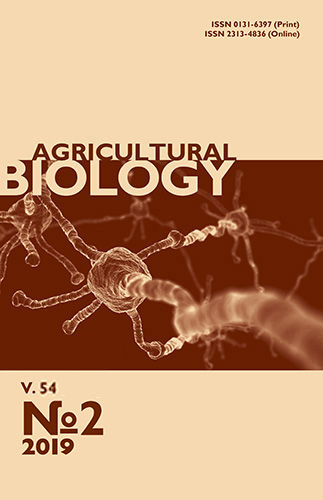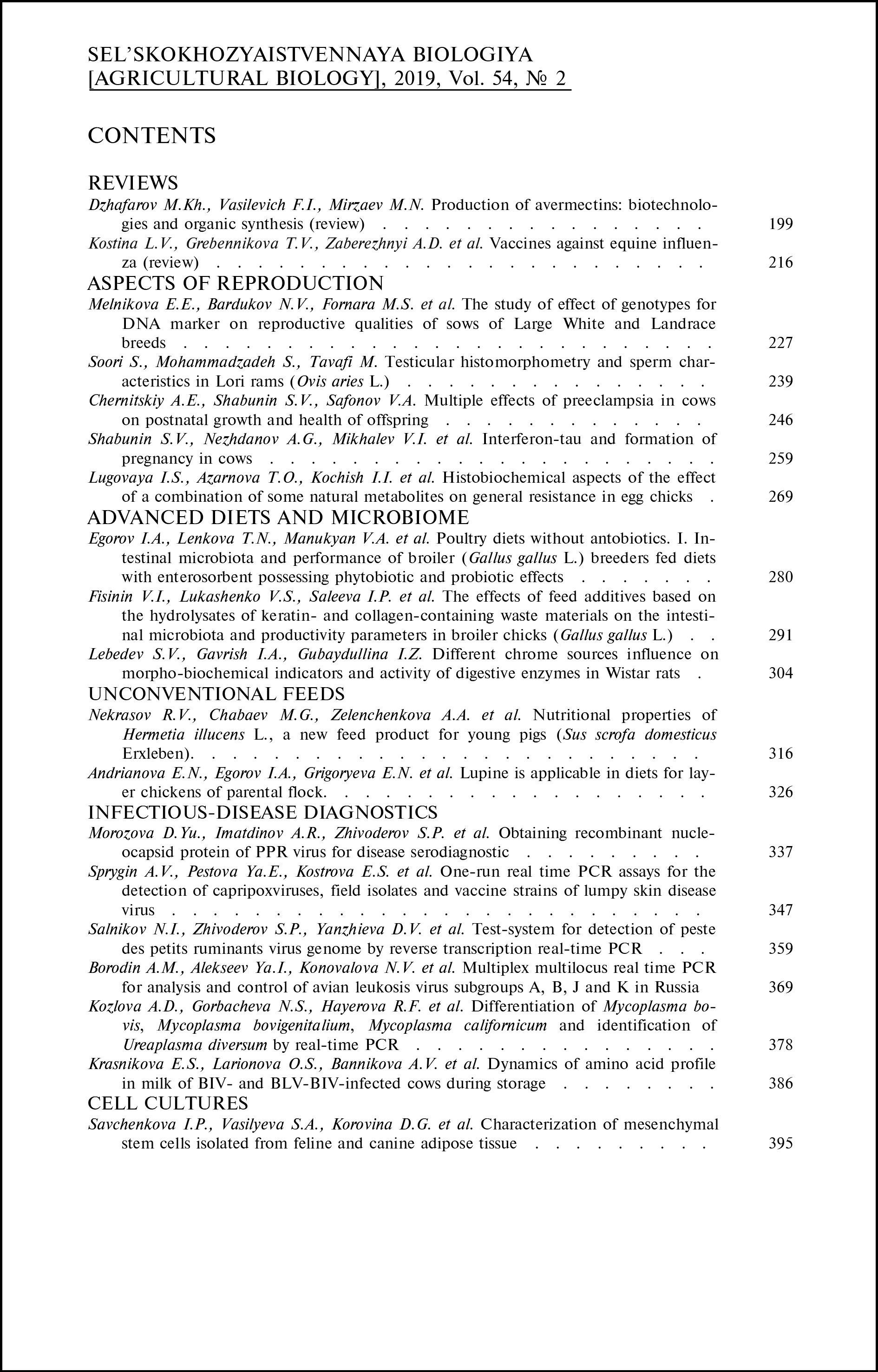doi: 10.15389/agrobiology.2019.2.227eng
UDC: 636.4:636.082:577.2
Acknowledgements:
The equipment of the Center for Biological Resources and Bioengineering of Farm Animals (Ernst Federal Science Center for Animal Husbandry)was used to conduct the study.
THE STUDY OF EFFECT OF GENOTYPES FOR DNA MARKER ON REPRODUCTIVE QUALITIES OF SOWS OF LARGE WHITE AND LANDRACE BREEDS
E.E. Melnikova, N.V. Bardukov, M.S. Fornara, O.V. Kostyunina, A.A. Sermyagin, G. Brem, N.A. Zinovieva
Ernst Federal Science Center for Animal Husbandry,60, pos. Dubrovitsy, Podolsk District, Moscow Province, 142132 Russia, e-mail melnikovaee@vij.ru (✉ corresponding author), bardukv-nikolajj@mail.ru,
margaretfornara@gmail.ru, kostolan@yandex.ru, alex_sermyagin85@mail.ru, gottfried.brem@agrobiogen.de, n_zinovieva@mail.ru
ORCID:
KMelnikova E.E. orcid.org/0000-0002-7498-1871
Sermyagin A.A. orcid.org/0000-0002-1799-6014
Bardukov N.V. orcid.org/0000-0002-5497-2409
Brem G. orcid.org/0000-0002-7522-0708
Fornara M.S. orcid.org/0000-0002-8844-177X
Zinovieva N.A. orcid.org/0000-0003-4017-6863
Kostyunina O.V. orcid.org/0000-0001-8206-3221
Received December 25, 2018
The genetic progress by low-inherited reproduction traits in pigs can be increased by integrating into breeding programs the DNA markers, which are associated with quantitative trait loci (QTL) of reproductive qualities (marker selection, MAS). The aim of the present study was to assess the effect of DNA markers IGF2 (insulin-like growth factor 2), ECR F18/FUT1 (Escherichia coli F18 receptor), ESR (estrogen receptor) and MUC4 (mucin 4) on the fertility traits of Large White and Landrace sows. The studied traits included the total number of piglets born per litter (TNB); number of piglets born alive per litter (NBA); average birth weight (BW) and adjusted birth weight (BWadj); weight at weaning at 21 days (WW) and adjusted weight at weaning at 21 days (WWadj). The genotypes frequencies of the analyzed markers were determined. Besides we identified significant deviations of the genotype frequencies from the population equilibrium for Large White breed by the IGF2 gene (p < 0.01) and Landrace breed by the IGF2 (p < 0.01), ECR F18/FUT1 (p < 0.01) and MUC4 (p < 0.001). The homozygosity coefficient according to Robertson (Ca) was the highest for genotypes for IGF2 and ECR F18/FUT1. The values of this parameters reached 0.76 and 0.65 for Large White breed against 0.60 and 0.72 for Landrace breed, respectively. We calculated the heritability coefficients for the analyzed traits, which were 0.165-0.179 for TNB, 0.100-0.155 for NBA, 0.232-0.338 for BW, and 0.010-0.115 for WW. Based on the developed equations, breeding values of pigs were determined using the BLUP AM method. The IGF2 marker showed a significant effect on the weight at weaning for Landrace sows (PHEWW, PHEWWadj, EBVWW); individuals with genotypes AA and AG were the best. The genotype for ECR F18/FUT1 significantly influenced the phenotype and breeding value of sows for the number of piglets born and for the birth weight of piglets. Sows with the AA genotype were characterized by a lower number of piglets born (by 8.0-8.5 %), and by a higher average birth weight (by 2.0-3.0 %). The significant effects of the ESR on TNB and NBA and on EBV values for birth weight were revealed: the sows of both breeds with CC genotype for ESR were characterized by highest average piglet weight at birth. We found the significant effect of MUC4 on birth weight of piglets for both breeds. Sows with CC and CG genotypes were superior comparing to individuals, which are homozygous for the G allele. Thus, using the marker assisted selection along with traditional methods for assessing the genetic potential of pigs (BLUP AM) will significantly improve the efficiency of breeding measures on the fertility traits.
Keywords: pigs, Large White breed, Landrace, IGF2, ECR F18/FUT1, ESR, MUC4, linear regression, fertility traits, estimated breeding values, marker assisted selection.
REFERENCES
- Torres Filho R.A., Torres R.A., Lopes P.S., Pereira C.S., Euclydes R.F., Araújo C.V., Silva M.A. Genetic trends in the performance and reproductive traits of pigs. Genetics and Molecular Biology, 2005, 28(1): 97-102 CrossRef
- Radojkovic D., Petrovic M., Radovic C., Parunovic N., Popovac M., Gogic M. Heritability and correlation of litter traits in pigs determined by REML method. Biotechnology in Animal Husbandry, 2012, 28(4): 771-778 CrossRef
- Mel'nikova E.E., Sermyagin A.A., Kharitonov S.N., Konte A.F., Trebunskikh E.A., Zinov'eva N.A. Svinovodstvo, 2019, 1: 13-17 (in Russ.).
- Ye J., Tan C., Hu X., Wang A., Wu Z. Genetic parameters for reproductive traits at different parities in Large White pigs. Journal of Animal Science, 2018, 96(4): 1215-1220 CrossRef
- Spötter A., Distl O. Genetic approaches to the improvement of fertility traits in the pig. The Veterinary Journal, 2006, 172(2): 234-247 CrossRef
- Wakchaure R., Ganguly S., Praveen P.K., Kumar A., Sharma S., Mahajan T. Marker assisted selection (MAS) in animal breeding: a review. J. Drug. Metab. Toxicol., 2015, 6: e127 CrossRef
- Rothschild M., Jacobson C., Vaske D., Tuggle C., Wang L., Short T., Eckardt G., Sasaki S., Vincent A., McLaren D., Southwood O., van der Steen H., Mileham A., Plastow G. The estrogen receptor locus is associated with a major gene influencing litter size in pigs. Proceedings of the National Academy of Sciences, 1996, 93(1): 201-205 CrossRef
- Wu Z.F., Liu D.W., Wang Q.L., Zeng H.Y., Chen Y.S., Zhang H. Study on the association between estrogen receptor gene (ESR) and reproduction traits in landrace pigs. Acta Genetica Sinica, 2006, 33(8): 711-716 CrossRef
- Goliášová E., Dvořák J. The oestrogen receptor gene (ESR) PvuII polymorphism allele frequencies in Czech Large White and Landrace. Acta univ. agric. et silvic. Mendel. Brun., 2005, LIII(2): 33-38.
- Omelka R., Bauerova M., Mlynek J., Buchova B., Peskovicova D., Bulla J. Effect of the estrogen receptor (ESR) gene on reproductive traits of Large White, White Meaty and Landrace pigs. Czech J. Anim. Sci., 2005, 50(6): 249-253 CrossRef
- Kostyunina O.V., Svezhentseva N.A., Zinov'eva N.A., Shakhin A.V., Dotsev A.V., Sizareva E.I., Shavyrina K.M., Gladyr' E.A., Ernst L.K. Dostizheniya nauki i tekhniki APK, 2011, 10: 57-58 (in Russ)
- Giniyatullin I.I., Rakhmatov L.A., Akhmetov T.M., Mullakhmetov R.R., Tyul'kin S.V. Uchenye zapiski Kazanskoi gosudarstvennoi akademii veterinarnoi meditsiny im. N.E. Baumana, 2016, 1: 107-109 (in Russ.).
- Kolosov A.Yu., Shirokova N.V., Maksimov G.V., Leonova M.A., Radyuk A.V. Agrarnyi vestnik Urala, 2016, 2(144): 17-19 (in Russ.).
- Wang S.J., Liu W.J., Yang L.G. Sargent C.A., Liu H.B., Wang C., Liu X.D., Zhao S.H., Affara N.A., Liang A.X., Zhang S.J. Effects of FUT1 gene mutation on resistance to infectious disease. Mol. Biol. Rep., 2012, 39(3): 2805-2810 CrossRef
- Zhu S., Liu Y., Dong W., Zheng X., Zhu G., Wu S., Bao W. Polymorphism of FUT1 gene M307 and its relationship with partial immune indexes and economic traits in Yorkshire pigs. Asian Journal of Animal and Veterinary Advances, 2014, 9(4): 253-261 CrossRef
- Getmantseva L.V., Mikhailov N.V., Kolosov A.Yu., Radyuk A.V. Izvestiya NV AUK, 2013, 3(31): 1-3 (in Russ.)
- Jørgensen C.B., Cirera S., Archibald A. L., Anderson L., Fredholm M., Edfors-Lilja I. Porcine polymorphisms and methods for detecting them. International application published under the patent cooperation treaty (PCT). PCT/DK2003/000807 or WO2004/048606-A2. 2004.
- Balcells I., Castelló A., Mercadé A., Noguera J.L., Fernández-Rodríguez A., Sànchez A., Tomàs A. Analysis of porcine MUC4 gene as a candidate gene for prolificacy QTL on SSC13 in an Iberian × Meishan F2 population. BMC Genetics, 2011, 31(12): 93 CrossRef
- Van Laere A.S., Nguyen M., Braunschweig M., Nezer C., Collette C., Moreau L., Archibald A.L., Haley C.S., Buys N., Tally M., Andersson G., Georges M., Andersson L. A regulatory mutation in IGF2 causes a major QTL effect on muscle growth in the pig. Nature, 2003, V(425): 832-836 CrossRef
- Kostyunina O.V., Kramarenko S.S., Svezhentseva N.A., Sizareva E.I., Zinov'eva N.A. The association of IGF2 with productive traits of pigs of large white breed in the aspect of sexual differentiation. Sel’skokhozyaistvennaya Biologiya [Agricultural Biology], 2015, 50(6): 736-745 CrossRef
- Karpushkina T.V., Kostyunina O.V., Sizareva E.I., Zinov'eva N.A. Dostizheniya nauki i tekhniki APK, 2016, 30(6): 82-85 (in Russ.">CrossRef
- Melnikova E.E., Bardukov N.V., Fornara M.S., Kostyunina O.V., Sermyagin A.A., Zaitsev A.M., Zinov'eva N.A. Effects of genotypes for IGF2, CCKAR and MC4R on the phenotypic estimations and breeding values for productive traits in pigs. Sel’skokhozyaistvennaya Biologiya [Agricultural Biology], 2018, 53(4): 723-734 CrossRef
- Misztal I., Tsuruta S., Strabel T., Auvray B., Druet T., Lee D.H. BLUPF90 and related programs (BGF90). Proc. 7th World Congress on genetics applied to livestock production. Montpellier, Communication, 2002, 28-27, 28: 21-22.
- Kostyunina O.V., Svezhentseva N.A., Zinov'eva N.A., Dotsev A.V., Shakhin A.V., Sizareva E.I., Gladyr' E.A. Effect of ESR and IGF2 marker genotypes on the breeding values of the large white boars. Sel’skokhozyaistvennaya Biologiya [Agricultural Biology], 2011, 6: 54-59 (in Engl.).
- Horogh G., Zsolnai A., Komiósi I., Nyíri A., Anton I., Fésüs L. Oestrogen receptor genotypes and litter size in Hungarian Large White pigs. Journal of Animal Breeding and Genetics, 2005, 122(1): 56-61 CrossRef
- Polozyuk O.N. Teoreticheskoe obosnovanie i prakticheskoe ispol'zovanie DNK-genotipirovaniya v selektsii svinei. Avtoreferat doktorskoi dissertatsii [Theoretical substantiation and practical use of DNA genotyping in pig breeding. DSc. Thesis]. Stavropol', 2013 (in Russ.).
- Horák P., Urban T., Dvořák J. The FUT1 and ESR genes – their variability and associations with reproduction in Přeštice Black-Pied sows. Journal of Animal Breeding and Genetics, 2005, 122(3): 210-213 CrossRef
- Bao W.B., Wu S.L., Cao J.J., Huang X.G., Chen G.H. Polymorphism of FUT1 gene and its relationship with litter size in Duroc pigs. Chin. J. Anim. Sci., 2009, 3: 5-7.
- Bao W.B., Ye L., Pan Z.Y., Zhu J., Zhu G.Q., Huang X.G., Wu S.L. Beneficial genotype of swine FUT1 gene governing resistance to E. coli F18 is associated with important economic traits. Journal of Genetics, 2011, 90(2): 315-318 CrossRef
- Fontanesi L., Bertolini F., Dall'Olio S., Buttazzoni L., Gallo M., Russo V. Analysis of association between the MUC4 g.8227C>G polymorphism and production traits in Italian heavy pigs using a selective genotyping approach. Animal Biotechnology, 2012, 23(3): 147-155 CrossRef
- Bannikova A.D. Polimorfizm DNK-markerov, assotsiirovannykh s vosproizvoditel'nymi kachestvami, u svinei porod krupnaya belaya i iorkshir. Kandidatskaya dissertatsiya [Polymorphism of DNA markers associated with reproductive qualities in Large White and Yorkshire pigs. PhD Thesis]. Dubrovitsy, 2012 (in Russ.)












